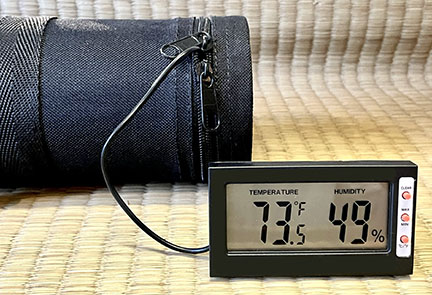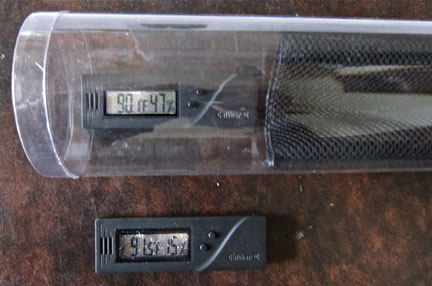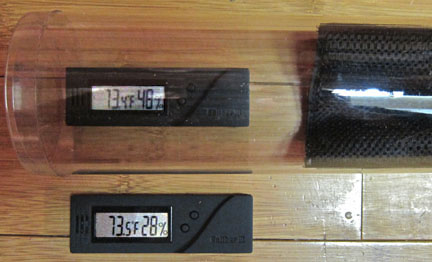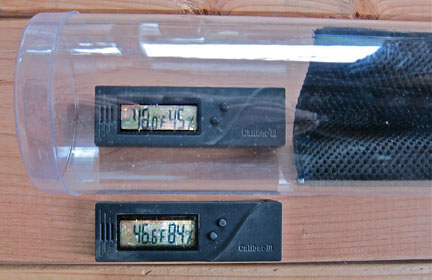
|
A Long-Awaited Breakthrough in Shakuhachi Care |

WHAT CAUSES BAMBOO TO CRACK?
The propensity of bamboo to split is an issue that has confronted shakuhachi players for centuries. "Confounded" may be a more apt description as the actual causes of cracking are as much of an enigma as the phenomenon itself, which usually occurs without forewarning and for no apparent reason. Nor is there much consensus amongst shakuhachi players, makers, teachers and researchers as how best to mitigate this problem or remedy the damage once it occurs. Using the analogy of an earthquake may seem like an overstatement, but not to a player whose beloved, precious instrument has suddenly and inexplicably self-destructed.
My goal in following discussion is to provide an overview of the bamboo cracking issue before introducing what I consider to be an remarkable new technology that has recently emerged.
Harvest and Curing of Madaké
Before considering external or ambient conditions affecting the stability of bamboo, let's examine some of the factors inherent in the biology of the plant itself and ways it is treated prior to being transformed into a musical instrument. To this end, I would like to focus on the intricate curing process for madaké and impact it may have on the longevity of a shakuhachi. Strict requirements regulate the harvesting of bamboo used for shakuhachi. Foremost amongst them are rules governing the aesthetics of madaké defined by convention and tradition that has evolved over centuries. Others, however, are intended to enhance the stability and durability of the raw material used in the flute making process.
Madaké (phyllostachys bambusoides Sieb. et Zucc.) bamboo grows only in a temperate zone occupying the middle latitudes of Japan. Travel too far north or south and it will not be found. One of nearly 1200 species in the world, madaké represents only about 10% of all the bamboo in Japan. Being a giant timber bamboo, the vast majority of groves are composed of culms too large in diameter to be used for flutes. Nonetheless, madaké is the only type bamboo traditionally used to make shakuhachi.
Nor does it help that virtually all parcels of land in the country, with the exception of riparian right of ways, are privately owned, further restricting access. While it is the fastest growing plant on Earth—madaké has been measured growing over four feet in a day—the total resource as been severely diminished over the last few decades due to rampant development and overpopulation. All of these factors, combined with exacting specifications demanded by the traditional aesthetic, make the search for shakuhachi bamboo a formidable one. A large grove provides the maker with only a very limited number of usable pieces.
The window of opportunity for harvesting madaké is quite narrow and timed around the winter solstice. This is when sap or resin is at a minimum and low in the plant. "Aburanuki" or "removal of oil" commences immediately after a root is dug up and it roots are cleaned and trimmed. Aburanuki involves heating the culm slowly and carefully over a radiant charcoal fire causing the sap to boil out through its open fibers. The pieces are then bleached in the weak winter sun as it arcs low in the sky for a period of about six weeks. In this procedure, it is critical that the roots be rotated 180 degrees daily and protected from any expose to rain or excessive moisture. After aburanuki and bleaching are completed, the bamboo is stored inside a cool, dry enclosure for a minimum of three years. During this period of slow drying, several pieces will crack and be discarded. The surviving roots are considered suitable and ready for crafting into a shakuhachi of appropriate size.
While much of the curing process is aimed at preventing infestation by insects, it also has an influence on the potential for cracking. In some ways, the entire endeavor can be regarded as culling process intended to eliminate "weak" culms likely to split prior to crafting. Not all shakuhachi makers who harvest their own bamboo employ the same methods for curing, nor is the thoroughness of their efforts guaranteed. In fact, most shakuhachi makers reside in urban areas close to the market for their product and do not even own a pair of work boots. Few are equipped for the arduous, time consuming and labor intensive work required in harvesting. Today, the majority of makers obtain their raw stock from bamboo brokers or middlemen who have a lock on the resource and whose quality of work cannot be assured or documented. For this reason, some makers have developed a reputation for having a higher crack rate than others, leaving the end user to assume any and all liability.
With this in mind, concern with cracking and efforts to mitigate its occurrence become all the more understandable.
Ambient Conditions
While bamboo is one of the world's strongest natural fibers along the axis of its grain, it's unique cellular structure provides little cohesion between those fibers. That, combined with the plant's columnular shape, sets up a scenario in which its inner and outer walls swell and contract at differing rates of expansion. When such repeated movement over time weakens the internal bond and the permissible limit of fiber cohesion is reached, then surpassed, the culm will split.
Many people erroneously assume that shakuhachi, being made from stout, thick-walled, root-end madaké, are more resist to cracking than other ethnic flutes like the North Indian bansuri, Chinese dizi and xiao, Andean kena or Middle Eastern ney that are fashioned from thin-walled bamboo. This is not the case. Thinner-walled bamboo has greater flexibility to swell and shrink without consequence unlike madaké whose interior and exterior surfaces expand and contract at different rates. This differential in movement is analogous to the variation in speed of a rotating disk like a CD or LP record. For a given unit of time, the rotational speed of the disk increases geometrically the further it is from the center of rotation. Likewise, pressure exerted on a column of bamboo as it expands results in far greater movement at the exterior surface of the tube, the area where cracking usually occurs.
In addition , shakuhachi taken from the relatively stable, humid atmosphere of Japan's four main islands to the wide variety of climatic conditions found in North America, Europe and Australia are particularly vulnerable. Bamboos are not especially happy in the dry, hot (and cold) conditions found at higher altitudes, in arid desert regions, nor in urban environments controlled by central heating and air conditioning. Splitting most frequently occurs during the winter months. Every year, around the winter solstice, my phone rings off the hook with distraught players who flutes have suddenly cracked and are in need of repair.
Finally, the degree of expansion and contraction represents only one factor in this equation. The frequency of swelling and shrinking over time is also contributes to fatigue of the molecular bond between the fibers of a bamboo culm. Environments exhibiting wide and frequent differentials in temperature and relative humidity literally wear out the bamboo and diminish its ability to remain intact. Bamboo, in general, and madaké bamboo used for shakuhachi, in particular, crave for atmospheric stability and prefer a narrowly proscribed ambient environment.
WHAT TO DO? STRATEGIC OPTIONS
Changes in atmospheric conditions due to climate, season and other factors are inevitable and cannot be avoided. Such environmental variations are a fact of life that must be addressed in any strategy for flute care. The available options up to this point, however, have been limited in scope and effectiveness as the preponderance of cracked bamboos clearly attest.
Over the many years I have been making shakuhachi, I've had the opportunity to collaborate with a number of folks inspired by the vision of "crackless bamboo". Foremost amongst them is John Kaizan Neptune, the great shakuhachi player, composer and maker who has spent decades exploring a number of different strategies aimed at addressing the cracking issue. Included in these efforts is a method developed to displace the moisture in green bamboo with polyethylene glycol (PEG) by immersing roots in black plastic ABS tubes and exposing them to solar radiation for a period of several months. More recently, John visited a government-run research facility on Kyushu Island, the bamboo center of Japan, where an intuitive technological process incorporated bamboo's inherent biological structure designed by nature to suck large quantities of water from ground level to the very top of the plant. In this process, a large reservoir of low viscosity liquid PEG was drawn through a three-meter long culm of giant green moso bamboo by a powerful vacuum pump designed to displace moisture in the fibers of the plant via capillary action. His most recent effort involved boiling bamboo in a bath of tongue oil to achieve the same end.
I too have conducted experiments along similar lines working with a company in the mid-West that developed a technology designed to force an acrylic-based compound into the pores of dense hardwood at enormous pressures. All of these strategies are based on the idea that replacing moisture and air trapped inside the cells of the bamboo with material that is more rigid and less elastic will serve to inhibit movement in a culm and, consequently, its propensity to crack. While interesting and to some degree effective, most of these attempts at stabilization have yielded limited results in spite of the extensive time, cost and resources that were expended. The reality of crackless bamboo remains a distant dream occupying its place at the end of a rainbow.
When all was said and done, I came to the conclusion that while these processes along with the Precision Cast Bore technology I developed may in some ways help to inhibit cracking, only the time-tested method of tightly binding a flute several places along its length would provide insurance against the occurrence of a catastrophic event. Binding applies mechanical restraints that set up a physical barrier limiting the bamboo's ability to swell and shrink beyond the cracking threshold. It proved to be so effective that I offer a lifetime guarantee against cracking into the bore for any new shakuhachi bound at the time of purchase. This guarantee, however, does not apply to surface cracks in the bamboo that may occur between the bindings but which rarely, if ever, penetrated into the bore rendering the shakuhachi unplayable. While preemptive binding coupled with the Precision Cast Bore technology may be considered as a step forward in the quest for crackless bamboo, the ultimate goal has not as yet been achieved.
All of the strategies discussed above focus on directly treating, fortifying or otherwise manipulating the bamboo itself in an effort to make it more stable and resistant to structural damage. A more indirect approach aims at controlling the environment in which a shakuhachi is stored when not being used in order to moderate changes that affect its internal structure. During the course of its life, a shakuhachi will spend far more time in storage than actually being played. In the vast majority of cases, and quite inexplicably, cracking tends to occur during this period of respite, in spite of the fact that a flute is exposed to a much narrower range of environmental changes when stored. If this environment could be strictly controlled and closely monitored, it seems reasonable to assume that the likelihood of cracking would be significantly reduced.
THE LIMITS OF FILL-TYPE HUMIDIFIERS
The most popular approach pursuing this strategy incorporates the use of a fill-type humidifier called a Dampit. The Dampit is nothing more than an absorbent wick designed to retain water encased in a perforated rubberized tube. This flexible snake-like device is inserted into the bore of a shakuhachi which is then stored in a vapor-barrier flute bag or sealed container. Moisture is then released into the atmosphere of the bag or case, driving up the relative humidity to a very high percentage.
Indeed, my own researches have corroborated that a length of bamboo supersaturated in this manner will hardly ever crack. Water is a medium that is compressive in nature, hence provides a modicum of stability as it displaces more elastic air inside the cells of a culm. The problem occurs when a flute is removed from this extreme and artificially protective environment each and every time it is played. As soon as the flute is exposed to the air, it begin releasing moisture into the environment since the relative humidity is much lower. This causes the bamboo to immediately begin contracting in size. When the flute is returned to it is sealed enclosure, the process is reversed. The sequence of events generated by this approach creates an extreme alternation of compressive and tensile forces resulting in swelling and shrinking that actually increases the likelihood of cracking rather than diminishing it. Instead of helping to establish atmospheric stasis and consistency, supersaturation of the bamboo sets up a shakuhachi for disaster resulting from the regime of environmental extremes to which it is repeatedly subjected.
To my thinking, establishing a relatively stable ambient environment for a shakuhachi to reside in makes far more sense. For this reason and from past experience, I have come to the conclusion that fill-type humidifiers actually do more harm than good when used as a permanent storage strategy. While some swear by the Dampit, I have long advocated acclimating one's flute to the environment in which it will be used on a day-to-day basis as being a more benign and effective approach. I recommend the Dampit be used only as a temporary measure in situations where an instrument is likely to be exposed to sudden and significant changes in temperature and relative humidity. For example, when traveling or being subjected to extreme climatic or seasonal conditions.
Compounding this problem is the fact that supersaturation requires constant vigilance in monitoring as well as a high degree of maintenance to assure that moisture is renewed on a regular basis and the flute does not dry out. In addition, during the warm summer months, increased ambient temperature induces the growth of mold and mildew, a common problem with fill-type humidifiers. These fungi can discolor the exterior of the bamboo and cause havoc inside the bore. Cleaning as shakuhachi to remove mold is relatively easy, but eliminating the odor completely is virtually impossible.
With effective techniques of crack prevention limited in this way, common sense (and prayer) remain the best approaches in caring for your shakuhachi. Up to this point in time, storing the flute in a vapor barrier bag and hard shell carrying case when not in use is as much as one could do to maintain a quasi-stable environment for the bamboo. Removing moisture from the bore after playing and occasionally oiling the outside of the flute may also be helpful in the long run.
The good news is that these practical limitations have been completely addressed with the advent of the FLUTE SAVER and its ability to maintain a very stable ambient environment for storage of your shakuhachi.
FLUTE SAVER FIELD TEST RESULTS
Just how effective is this new technology? Recently, I have conducted a field test in order to verify how successful (or not) the FLUTE SAVER was in stabilizing relative humidity inside a sealed container. In this controlled experiment, conducted twenty-four hours a day, seven days a week over a four week period, I monitored ambient temperature and relative humidity inside and out of an enclosed environment that contained a single FLUTE SAVER packet. This experiment incorporated a range of natural environments intended to emulate extremes of temperature and humidity that a shakuhachi would be likely to encounter in a variety of climatic conditions.
The results of this test are summarized in the following chart.
| Photos of Data Readings | Temperature and RH Range / Conditions | Outside |
Inside Flute Saver Temperature (Degrees F) |
Outside |
Inside Flute Saver Relative Humidity |
 |
HIGH TEMPERATURE/
This emulates peak summer season conditions in many parts of the world, regional high elevations and semi-arid desert conditions as well as extremes of indoor climate using unregulated forced air heating without humidification. |
91.5 | 90.1 | 15% | 47% |
 |
MODERATE TEMPERATURE/ MEDIUM RELATIVE HUMIDITY Ambient condition: This emulates indoor conditions slightly above room temperature and somewhat lower RH than optimum. |
73.5 | 73.4 | 28% | 48% |
 |
LOW TEMPERATURE/ HIGH RELATIVE HUMIDITY Ambient condition: This emulates seasonal conditions in many parts of the world that experience cool wet winter weather. |
46.6 | 48.0 | 84% | 45% |
| Note: The digital humidity meter used in this test came with the earlier model Flute Saver which did not have a wired probe and external meter. Thus, the meter pictured is located inside the enclosure. The new improved Flute Saver design requires only the probe itself be inside the enclosure allowing the meter to be placed more conveniently for viewing. | |||||
As can see, the FLUTE SAVER succeeded in creating and maintaining a remarkably consistent and uniform RH within the desired range of 40% - 60% in a wide diversity of atmospheric conditions.
In spite of these impressive results, I would hasten to add that, even with consistent and proper use, the FLUTE SAVER does not provide a 100% guarantee that your shakuhachi will not crack since the instrument must, by necessity, be subjected to a changes in atmospheric conditions when being played. However, with this caveat in mind, I believe that this remarkable new technology represents a tremendous improvement in the options now available in caring for your shakuhachi. It is a giant step forward that has changed the rules of the game.
If you would like to learn more about the FLUTE SAVER, issues related to shakuhachi care and extensive information on bamboo crack prevention, go to these links.
The FLUTE SAVER: A Long-Awaited Breakthrough in Shakuhachi Care |
| FLUTE SAVER Field Test Results |
| FLUTE SAVER Instructions for Set Up & Use |
| FLUTE SAVER Reviews |
| Price of FLUTE SAVER Kits & Components | Ordering Information |